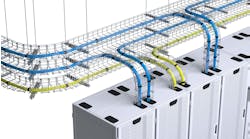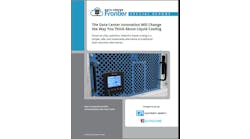Cato Rolls Out Bare Metal Platform: 'Like AirBnB for Servers'
Dean Nelson has spent years trying to squeeze every bit of efficiency out of data centers. One of the biggest remaining challenges is how data centers manage electricity, which often involves overprovisioning to prepare for "just in case" scenarios.
Nelson has championed the use of software-defined power, a strategy to allow data center operators to use more of the power and space in their facilities. As any new approach, companies running mission-critical infrastructure want to see the technology in action first.
So Nelson, the CEO of Cato Digital, has created a new offering that can bring software-defined power into the world's busiest data centers and carrier hotels. The Cato Bare Metal platform uses repurposed servers and rents on-demand capacity by the hour, day or month.
"It's like AirBnB for servers," said Nelson, who says Cato's servers are priced at half the cost of major cloud providers. Nelson has previously served in data center leadership positions at eBay, Uber and Sun Microsystems, and is the founder and chairman of Infrastructure Masons.
Cato recently launched its platform at 60 Hudson Street, the iconic New York carrier hotel that is one of the world's most connected buildings. Cato is hosting its gear in the Hudson Interxchange (Hudson IX) data center, where it will run high-density workloads for Neu.ro, which specializes in artificial intelligence and machine learning. It also has a West Coast presence in a Cyxtera data center in Silicon Valley, and a site under development with KASI Cloud in Lagos, Nigeria.
"Hudson IX is the ideal data center partner with one of the world’s most concentrated hubs of internet connectivity," said Nelson. "By simultaneously launching the Neu.ro platform at Hudson IX’s 60 Hudson St. facility, we are enabling highly sustainable computing that ranges from general purpose to leading edge GPT-like services.”
"Hudson IX is delighted to be a critical partner to amplify Cato's Bare Metal platform," said Tom Brown, President and CEO of Hudson IX. "Our world-class data center's robust interconnected ecosystem and expansion capacity enable customers to accelerate their reach and scale."
Showcasing Software-Defined Power
In addition to providing low-cost on-demand capacity, the bare metal platform lets colocation operators get a close look at Cato Digital's M9 software and power orchestration platform. Software-defined power extends virtualization to the power plane, offering new levels of efficiency and automation to data centers by using software management to reallocate power between racks and servers based on real-time usage patterns.
Cato's technology uses a combination of software and distributed batteries to conduct peak shaving, using the batteries to store power and allocate it to the system when needed, creating a more elastic system for distributing power. The batteries and power flows are managed by a software suite, which allocates power from utility sources, UPS systems and batteries.
Cato Digital was previously known as Virtual Power Systems, and the new brand reflects the expansion into hosting services.
VPS had been positioning its software for colocation providers, which wrestle with stranded power capacity because they have multiple customers, and need buffers and redundancy to guarantee uptime for their SLAs. Thus far the public users include companies involved in data center management, including CBRE, T5 Data Centers and Schneider Electric.
Economics Tied to SLAs
Cato created the bare metal platform to showcase a holistic rack-level example of advanced power and capacity management within a colo environment. Nelson says Cato can effectively operate in the margins of a data center's power envelope, with its orchestration software providing the ability to shed load in periods of high power usage.
"All this extra room is wasted, and we can monetize it," said Nelson. "We don't need to be contiguous within the data center, either. If you've got Swiss cheese, we can help fill it."
Cato's economics are linked to a service-level agreement (SLA) that promises 2.5 "nines" of power (99.5 percent uptime) as opposed to the five 9s (99.999 percent uptime) seen in many provider SLAs. As a result, its offering may not be ideal for every customer. But for those who are comfortable with the SLA, the economics are attractive.
Cato has some novel approaches, but it's not the only player in this niche. The notion of "AirBnB for servers" has also been advanced by Mutable, which operates an edge cloud by monetizing underutilized servers, allowing companies to rent their extra capacity to third-party developers. Mutable is working with the Kinetic Edge Alliance organized by Vapor IO and other micro data centers deploying 5G equipment.
Making AI More Sustainable
The first Cato tenant at Hudson IX will be Neu.ro, an AI specialist that helps companies train, fine-tune, and run their own private GPT-like services such as ChatBots, Semantic Search, Document Processing, Generative AI, and more.
Neu.ro was attracted to the sustainability story of the Cato platform, which runs on repurposed "circular economy" servers, for which the majority of the embodied carbon impact has already been offset. Cato says it uses renewable energy for its services, providing carbon free computing.
"We have built sustainability into our platform from day one," said Uri Soroka, CEO of Neu.ro. "Our software optimizes the performance and efficiency of machine learning and AI workloads. By running on Cato bare metal, we accelerate the reduction of carbon. Our customers directly benefit from this combined solution by not having to make a trade off between cost or sustainability.”
Cato, Neu.ro and Hudson Interxchange all belong to the iMasons Climate Accord, a coalition of over 200 global data center companies working toward a methodology to measure and reduce carbon in digital infrastructure.






